Goma Gorilla Orphans
By Gorilla Doctors Staff on Wednesday, October 21st, 2009 in Uncategorized.There are five gorilla orphans living in Goma DRC. They were rescued from largely unknown situations and thanks to hard working Gorilla Doctors and caregivers they are now thriving.
Amani, Kighoma and Mapendo are all Grauer’s gorillas. Amani and Kighoma were confiscated this year on the Congo side of the Virunga range. They came to us in very bad condition. Just babies, they have been nursed back to health and now love to laugh and play together. Mapendo is about five years old and was confiscated in December 2007. She lived with her three very supportive and dedicated caregivers until last month when she was introduced to Amani and Kighoma. That introduction went very well – Mapendo was so happy to romp and laugh and play with little Amani and Kighoma. You may have read about it on our Facebook page!
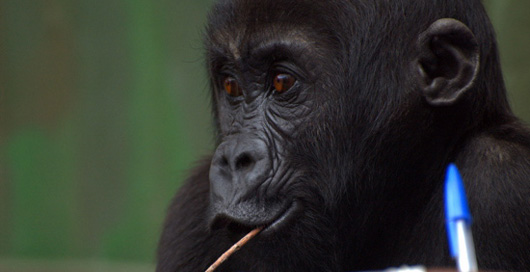
Here’s Amani, looking very cute!
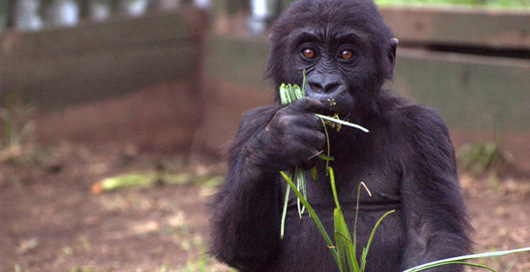
Kigoma enjoying some forest food.
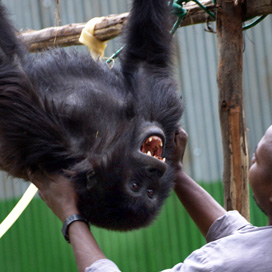
Mapendo laughing with her caregiver.
Ndakasi and Ndeze are Mountain Gorilla orphans, both about three years old. Ndakasi was only two months old when she was rescued in June 2007. Ndeze was rescued not long after Ndakasi, also very young. Both were orphaned by the horrible gorilla murders that occurred in 2007. You may have seen the story on National Geographic. Their mothers, along with the silverback Senkwekwe who certainly must have tried to save his family, are buried in a small graveyard at Park Headquarters in Rumangabo along with the other gorillas that were murdered that year.
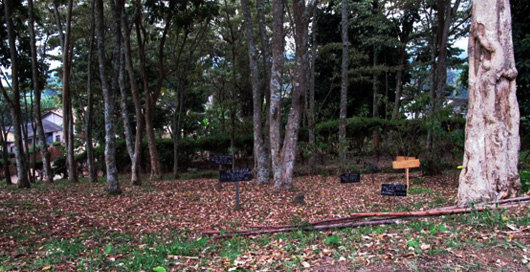
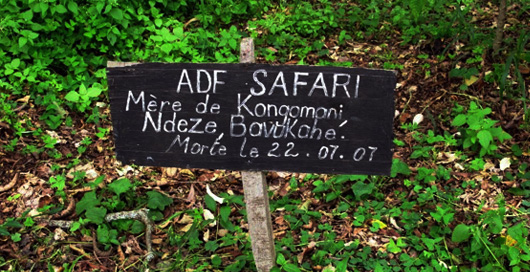
This is the grave marker of Ndeze’s mother.
These babies endured horrors we cannot imagine, but they are fighters. They survived. And now they are fast friends. Ndakasi is determined little girl, keeping her caregivers on their toes with her antics, and Ndeze expresses her happiness by producing a huge smile while she plays!
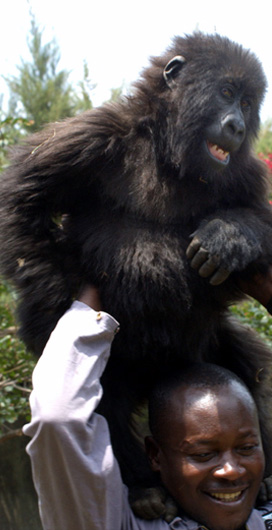
Ndakasi romping with her caregiver.
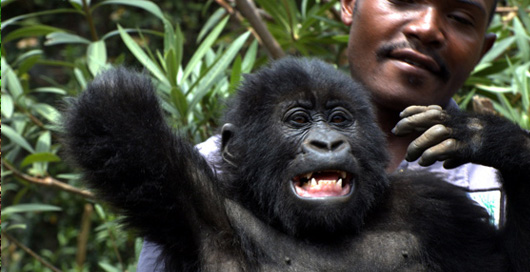
Here’s Ndeze’s smile!
Ndeze and Ndakasi currently live in a house in Goma with their very dedicated and loving caregivers. But they will all soon move to a new facility built by ICCN, (Institut Congo pour la Conservation de la Nature), near the town of Rumangabo, DRC. This week I traveled to Rumangabo with Dr. Eddy to take a look at the progress of the facility, and to meet with Emmanuel de Merode, the Director of Parc National des Virunga, to work out the schedule for moving these two to their new home.
The trip started by crossing the border into Goma, DRC. Roads in Congo are very rough and dusty, and the city is crowded and loud, but people are open and welcoming. Part of the city is still covered in lava from when Nyiragongo Volcano erupted in 2002. It left 2 meters of lava in the town, but was slow moving so nearly everyone was able to evacuate. Goma is rebuilding, and it is interesting to see that some of the shops now have basements that used to be at ground level.
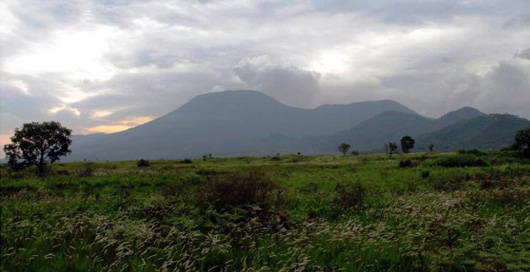
Here’s Nyiragongo – you can see the steam plume mixing with the clouds.
As we drove north toward Rumangabo the city gave way to the countryside which is dotted with cultivated fields. We are always very careful when we come to DRC. Dr. Eddy and Dr. Jacques know the area well. Today things seemed to be business as usual, but there are signs of previous unrest everywhere. UN trucks and bases are a common site. Huge charcoal trucks guarded by soldiers rumble up and down the rocky, dusty road. Soldiers are a common site. We pass several remnants of refugee camps. But people are coming back, and communities are being redeveloped and are once again busy with daily activities.
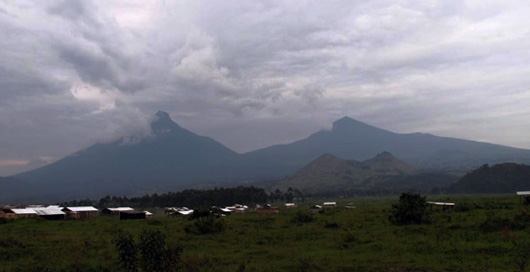
Refugee camps in the shadow of the volcanoes.
At one point we drove through a small corridor of protected park that links the Virunga range, and gorilla habitat, with the western part of the park that is Chimpanzee habitat. The trees are huge with moss covered limbs and the air is cool and clear. A blue monkey crossed the road as we passed through the corridor – it felt wonderful to be back in the forest after the dusty roads! As we approach Park Headquarters I recognized the main building from the National Geographic special about the gorilla murders. Rebels used to control this area. But it is now in the hands of ICCN, and wonderful community work is being done in the area. ICCN is building schools in the communities surrounding the park. They are funding a program where families can start a business making “bio bricks” – an ecologically friendly alternative to charcoal (MGVP is bringing this program to Rwanda next month!). Gorilla tourism is coming back, and ICCN manages the trackers and guides for that program. And they are building a great facility for these little orphans, even while they continue to face armed interactions in the Nyiragongo part of the park.
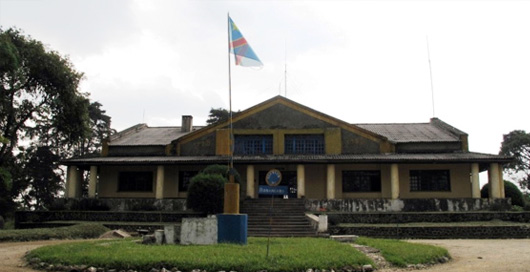
The forest around the park headquarters is beautiful. The new enclosure for Ndaksi and Ndeze is filled with natural forest plants and trees, and is the right altitude and climate for these baby Mountain Gorillas. There are baboons, blue monkeys and Colobus monkeys in the area, and for health and safety reasons we will try to exclude them from the enclosure. The night quarters are composed of 4 rooms – 2 bedrooms, a kitchen and entry room. Dr. Eddy and I walk the perimeter of the yard and look over the night house. It is nearly done. As I look around I know that they will be very comfortable here – I can visualize them playing in the giant yard with the caretakers they know and love. We’ll be moving them in November – stay tuned for the story of that adventure!
Help the Gorilla Doctors.


 Donate
Donate